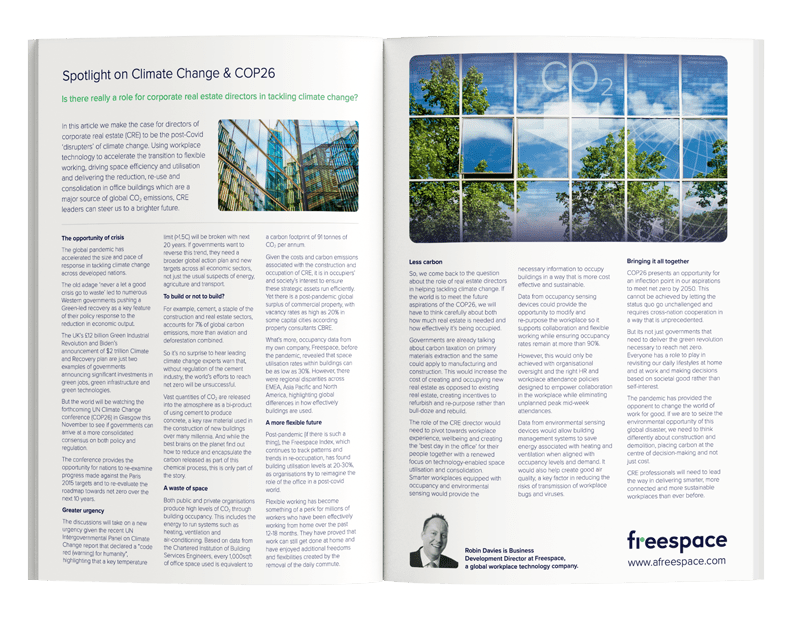Is there really a role for corporate real estate directors in tackling climate change?
In this article we make the case for directors of corporate real estate (CRE) to be the post-Covid ‘disrupters’ of climate change. Using workplace technology to accelerate the transition to flexible working, driving space eff ciency and utilisation and delivering the reduction, re-use and consolidation in offi ce buildings which are a major source of global CO2 emissions, CRE leaders can steer us to a brighter future.
The opportunity of crisis
The global pandemic has accelerated the size and pace of response in tackling climate change across developed nations.
The old adage ‘never a let a good crisis go to waste’ led to numerous Western governments pushing a Green-led recovery as a key feature of their policy response to the reduction in economic output.
The UK’s £12 billion Green Industrial Revolution and Biden’s announcement of $2 trillion Climate and Recovery plan are just two examples of governments announcing significant investments in green jobs, green infrastructure and green technologies.
But the world will be watching the forthcoming UN Climate Change conference (COP26) in Glasgow this November to see if governments can arrive at a more consolidated consensus on both policy and regulation.
The conference provides the opportunity for nations to re-examine progress made against the Paris 2015 targets and to re-evaluate the roadmap towards net zero over the next 10 years.
Greater urgency
The discussions will take on a new urgency given the recent UN Intergovernmental Panel on Climate Change report that declared a “code red (warning) for humanity”, highlighting that a key temperature limit (>1.5C) will be broken with next 20 years. If governments want to reverse this trend, they need a broader global action plan and new targets across all economic sectors, not just the usual suspects of energy, agriculture and transport.
To build or not to build?
For example, cement, a staple of the construction and real estate sectors, accounts for 7% of global carbon emissions, more than aviation and deforestation combined.
So it’s no surprise to hear leading climate change experts warn that, without regulation of the cement industry, the world’s efforts to reach net zero will be unsuccessful.
Vast quantities of CO2 are released into the atmosphere as a bi-product of using cement to produce concrete, a key raw material used in the construction of new buildings over many millennia. And while the best brains on the planet find out how to reduce and encapsulate the carbon released as part of this chemical process, this is only part of the story.
A waste of space
Both public and private organisations produce high levels of CO2 through building occupancy. This includes the energy to run systems such as heating, ventilation and air-conditioning. Based on data from the Chartered Institution of Building Services Engineers, every 1,000sqft of offi ce space used is equivalent to a carbon footprint of 91 tonnes of CO2 per annum.
Given the costs and carbon emissions associated with the construction and occupation of CRE, it is in occupiers’ and society’s interest to ensure these strategic assets run eff ciently. Yet there is a post-pandemic global surplus of commercial property, with vacancy rates as high as 20% in some capital cities according property consultants CBRE.
What’s more, occupancy data from my own company, Freespace, before the pandemic, revealed that space utilisation rates within buildings can be as low as 30%. However, there were regional disparities across EMEA, Asia Pacific and North America, highlighting global differences in how effectively buildings are used.
A more flexible future
Post-pandemic (if there is such a thing), the Freespace Index, which continues to track patterns and trends in re-occupation, has found building utilisation levels at 20-30%, as organisations try to reimagine the role of the offi ce in a post-covid world.
Flexible working has become something of a perk for millions of workers who have been e ectively working from home over the past 12-18 months. They have proved that work can still get done at home and have enjoyed additional freedoms and flexibilities created by the removal of the daily commute.
Less carbon
So, we come back to the question about the role of real estate directors in helping tackling climate change. If the world is to meet the future aspirations of the COP26, we will have to think carefully about both how much real estate is needed and how effectively it’s being occupied.
Governments are already talking about carbon taxation on primary materials extraction and the same could apply to manufacturing and construction. This would increase the cost of creating and occupying new real estate as opposed to existing real estate, creating incentives to refurbish and re-purpose rather than bull-doze and rebuild.
The role of the CRE director would need to pivot towards workplace experience, wellbeing and creating the ‘best day in the o ffice’ for their people together with a renewed focus on technology-enabled space utilisation and consolidation. Smarter workplaces equipped with occupancy and environmental sensing would provide the necessary information to occupy buildings in a way that is more cost effective and sustainable.
Data from occupancy sensing devices could provide the opportunity to modify and re-purpose the workplace so it supports collaboration and flexible working while ensuring occupancy rates remain at more than 90%.
However, this would only be achieved with organisational oversight and the right HR and workplace attendance policies designed to empower collaboration in the workplace while eliminating unplanned peak mid-week attendances.
Data from environmental sensing devices would allow building management systems to save energy associated with heating and ventilation when aligned with occupancy levels and demand. It would also help create good air quality, a key factor in reducing the risks of transmission of workplace bugs and viruses.
Bringing it all together
COP26 presents an opportunity for an inflection point in our aspirations to meet net zero by 2050. This cannot be achieved by letting the status quo go unchallenged and requires cross-nation cooperation in a way that is unprecedented.
But its not just governments that need to deliver the green revolution necessary to reach net zero. Everyone has a role to play in revisiting our daily lifestyles at home and at work and making decisions based on societal good rather than self-interest.
The pandemic has provided the opponent to change the world of work for good. If we are to seize the environmental opportunity of this global disaster, we need to think differently about construction and demolition, placing carbon at the centre of decision-making and not just cost.
CRE professionals will need to lead the way in delivering smarter, more connected and more sustainable workplaces than ever before.



Robin Davies
Business Development Director
Robin Davies is Business Development Director at Freespace, a global workplace technology company.
